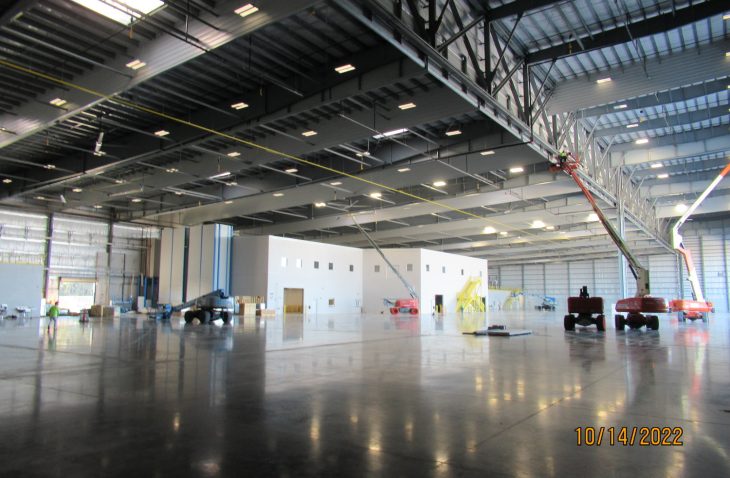VTMAE MRO Hanger Facility Phase 2

IMEG provided structural, mechanical, electrical, plumbing, and technology engineering design, along with construction phase services, for Phase 2 of the new VT Mobile Aerospace Engineering (VTMAE) Maintenance, Repair and Overhaul (MRO) Hangar adjacent to the hangar constructed in 2018. The site has airside access off Runway 17-35 and landside access off Langley Avenue via Merlion Way. The terms of the development agreement include requirements for the planning, design, and construction of this new facility.
The new 195,500-sf facility services commercial aircraft including the B777 (excluding the 9X), B757, B737, DC10, MD10, MD11, B767, A300, A220, A330, and A320 family.
The complete facility included a two-phase development consisting of the following components:
- One large double-bay aircraft maintenance hangar
- Modification of the existing Hangar 1 entrance/parking lot to permit direct entry/egress into Hangar 2 site for freight loading dock and parking area
- Climate controlled Low Bay area including access road and covered walkway
- Aircraft parking apron
- One connector taxilane to Hangar 2
- Partial relocation of the perimeter security fence
- Vehicle parking area at Hangar 2 and low bay (353 spaces provided)
- Site preparation including removal of pavement, clearing and grubbing, and grading
- Extension of stormwater management system
- Wooded buffer between planned facility and adjacent residential areas
- Covered hazardous waste material disposal point with 8’ protective fencing and double gate
- 120V power, 1” compressed air and LED lighting, two 1,000-gallon tanks for waste oil and Jet A storage, and 2,000 gallon tank for gas
- Ramp utilities, three pneumatic air supplies (engine start and 1”) and three 400 Hz aircraft power supplies for line operations for aircraft on the apron
- Rainwater harvesting for aircraft wash operations per aircraft maintenance specifications
Structural design included a foundation system for the hangar consisting of a combination of deep and shallow foundations. The front box truss for the pre-engineered metal hangar superstructure has large compression and tension loads at the foundations. The mono slope roof structure has a peak at the front of hangar — a structural standing seam metal roof system was used. Two 2-ton traveling bridge cranes are supported by the hangar. The floor slabs were designed to accommodate aircraft and vehicle loading, as well as the concentrated loading due to the aircraft jacks placed in the floor slab.
Mechanical engineering design for the new facility HVAC system included multiple chilled water air handlers to provide comfort conditioning for the office-type and workshop areas. The chilled water system consists of one 200-ton air-cooled chiller serving a variable primary pumping chilled water distribution system with a single distribution loop.
Electrical engineering design includes a new 480Y/277V, three phase, 4-wire main electrical service consisting of a 4000A main switchboard and a secondary distribution system. A secondary power distribution system consists of 480Y/277V panelboards which connects new HVAC equipment, shop equipment, 400Hz aircraft power equipment, and various lighting loads. Interior and exterior lighting systems consist of LED source luminaires and new lighting controls throughout the facility.







